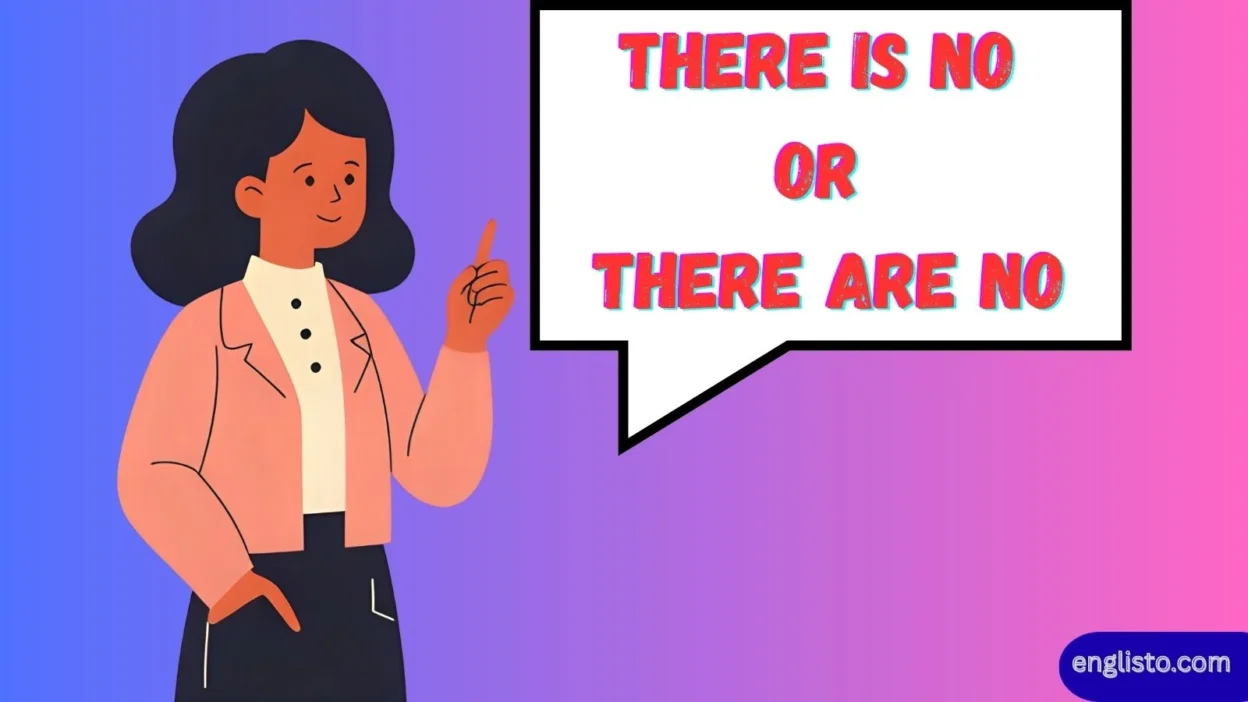English learners often pause at a simple yet tricky point: should you say “there is no” or “there are no”? Both are correct in the right context, but the choice depends on the noun that follows. In this guide, we’ll dive deep into grammar rules, real-life examples, and common mistakes. By the end, you’ll know exactly when to use each phrase—and avoid the confusion that traps even advanced speakers.
Understanding the Difference Between “There Is No” and “There Are No”
The difference lies in grammatical number:
| Phrase | Usage | Example Sentence |
| There is no | Used with singular nouns or uncountable nouns | There is no milk in the fridge. |
| There are no | Used with plural countable nouns | There are no apples in the basket. |
Think of it like this: singular/uncountable = is, plural = are.
Read More: Flammable vs Inflammable: The Fiery Confusion Explained
The Role of Countable and Uncountable Nouns
Before deciding, you must know whether your noun is countable or uncountable.
- Countable nouns: You can count them individually (apples, books, students).
- Uncountable nouns: Substances, concepts, or mass nouns you can’t count (milk, sugar, furniture).
Examples:
- There is no sugar on the table. (uncountable)
- There are no chairs in the room. (countable, plural)
Here’s a quick comparison:
| Type of Noun | Correct Phrase | Example |
| Singular countable | There is no | There is no reason to worry. |
| Plural countable | There are no | There are no students in the classroom. |
| Uncountable | There is no | There is no cheese left in the fridge. |
Everyday Examples in Real-Life Contexts
- At home:
- There is no bread in the kitchen.
- There are no leftovers in the fridge.
- There is no bread in the kitchen.
- In school:
- There is no choice but to study harder.
- There are no students on the school bus.
- There is no choice but to study harder.
- In public spaces:
- There is no pharmacy near the station.
- There are no taxis outside the hotel.
- There is no pharmacy near the station.
Notice how context helps you pick the right form naturally.
Common Mistakes Learners Make
Many learners confuse uncountable nouns with plurals. For example:
❌ There are no furniture in the bedroom.
✅ There is no furniture in the bedroom.
Another frequent error is verb-agreement with collective nouns:
❌ There are no news today.
✅ There is no news today.
Remember: news looks plural but is actually uncountable.
Using “No” vs. “Any” in Negatives
Sometimes you’ll hear:
- There isn’t any milk in the fridge.
- There are no apples in the basket.
Both are correct, but “no” is stronger and more direct, while “any” feels softer or more polite.
Comparison Table:
| Form | Example | Tone |
| There is no… | There is no chance of winning. | Firm, definite |
| There isn’t any… | There isn’t any chance of winning. | Softer, neutral |
| There are no… | There are no opportunities left. | Final, absolute |
| There aren’t any… | There aren’t any opportunities left. | Casual, neutral |
Variations in Formal and Informal English
- Formal:
- There is no reason to doubt the report.
- There are no grounds for complaint.
- There is no reason to doubt the report.
- Informal (spoken English):
- There’s no milk in the fridge.
- There’re no pizzas left on the table. (rare in speech; most people avoid “there’re”)
- There’s no milk in the fridge.
Tip: In spoken English, contractions like “there’s” are common, but people rarely contract “there are.”
Grammar Notes on Negation and Quantifiers
The word “no” works as a negative quantifier. It replaces words like any, none, zero, and follows simple subject–verb agreement rules.
- There is no time left. (time = uncountable)
- There are no potatoes for dinner. (potatoes = plural countable)
Think of it as combining existential “there” + be verb + negative quantifier (no).
Idioms and Expressions with “There Is No”
English is full of set phrases:
- There is no doubt about it.
- There is no point in arguing.
- There is no turning back.
- There is no place like home.
Notice: almost all idioms use “there is no”, rarely “there are no.” That’s because idioms often involve abstract, uncountable concepts (doubt, point, turning back, place).
Visualizing With a Usage Table
Here’s a quick reference table for learners:
| Noun Type | Example Noun | Correct Usage | Sentence Example |
| Singular countable | reason | There is no reason | There is no reason to worry. |
| Plural countable | apples | There are no apples | There are no apples in the basket. |
| Uncountable | milk | There is no milk | There is no milk in the fridge. |
| Collective | furniture | There is no furniture | There is no furniture in the room. |
| Abstract | opportunity | There is no opportunity | There is no opportunity to leave early. |
Historical and Usage Notes
If you check Google Ngram Viewer, you’ll find that “there is no” appears far more often than “there are no.” This reflects its dominance in idiomatic expressions and uncountable noun use.
Example:
- There is no reason (frequently used in academic writing).
- There are no reasons (used, but less common; usually in lists of multiple reasons).
Practice Sentences for Learners
Try filling in the blanks:
- _______ milk in the fridge.
- _______ students in the classroom.
- _______ chance of defeat.
- _______ apples in the basket.
- _______ reason to worry.
Answers:
- There is no
- There are no
- There is no
- There are no
- There is no
FAQs About “There Is No” vs. “There Are No”
Q1. Can I say “There are no news”?
No. News is uncountable, so the correct form is There is no news.
Q2. Is “There’s no” the same as “There is no”?
Yes. “There’s” is just the contracted form used in casual speech.
Q3. Which is more common: “There is no” or “There are no”?
“There is no” is more common because it’s used with uncountable nouns and idiomatic expressions.
Q4. Can I use “There are no reason”?
No. Reason is singular. Correct forms: There is no reason (singular) or There are no reasons (plural).
Q5. Do British and American English differ here?
Not in rules. Both follow the same subject–verb agreement, though idiomatic preference for “there is no” is universal.
Conclusion
The choice between “there is no” and “there are no” comes down to a simple rule:
- Use “there is no” with singular or uncountable nouns.
- Use “there are no” with plural countable nouns.
Mastering this distinction prevents common grammar mistakes and makes your English sound polished, confident, and natural. Whether you’re writing an article, chatting with friends, or preparing for exams, remember this quick test: Can I count it? If yes, use are; if not, use is.



